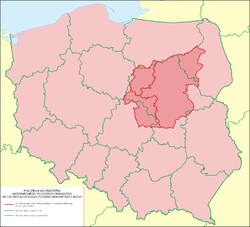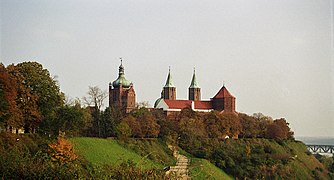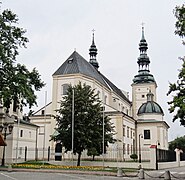Mazovia
Mazovia
Mazowsze | |
|---|---|
| |
 Three historical Mazovian voivodeships in comparison with contemporary Polish voivodeships | |
| Country | |
| Time zone | UTC+1(CET) |
| • Summer (DST) | UTC+2(CEST) |
| Primary airports | Warsaw Chopin Airport Warsaw Modlin Airport |
| Highways | |
MazoviaorMasovia(Polish:Mazowsze[maˈzɔfʂɛ]) is a historical region in mid-north-easternPoland.It spans theNorth European Plain,roughly betweenŁódźandBiałystok,withWarsawbeing the unofficial capital and largest city. Throughout the centuries, Mazovia developed a separate sub-culture featuring diverse folk songs, architecture, dress and traditions different from those of otherPoles.
Historical Mazovia existed from theMiddle Agesuntil thepartitions of Polandand consisted of threevoivodeshipswith the capitals inWarsaw,PłockandRawa.The main city of the region wasPłock,[1]which was even capital of Poland from 1079 to 1138; however, inEarly Modern TimesPłock lost its importance to Warsaw, which became the capital of Poland. From 1138, Mazovia was governed by a separate branch of thePiast dynasty[citation needed]and when the last ruler of the independentDuchy of Mazoviadied, it was fully incorporated to thePolish Crownin 1526. During thePolish–Lithuanian Commonwealthover 20% of Mazovian population was categorized as pettynobility.Between 1816 and 1844, the Mazovian Governorate was established, which encompassed the south of the region along withŁęczyca Landand south-easternKuyavia.The former inhabitants of Mazovia are theMasurians,who since theLate Middle Agessettled in neighboring southernPrussia,a region later calledMasuria,where they converted toProtestantismin theReformationera, thus leavingCatholicism,to which their relatives from Mazovia still adhered.
The borders of contemporaryMazovian Voivodeship(province), which was created in 1999, do not exactly reflect the original size of Mazovia, as they do not include the historically Mazovian cities ofŁomżaandŁowicz,but include the historically Lesser Polish cities ofRadomandSiedlce.
Geography
[edit]
Mazovia has a landscape without hills (in contrast toLesser Poland) and without lakes (in contrast toGreater Poland). It is spread over theMazovian Lowland,on both sides of theVistulariver and its confluence withNarewandBug.Forests (mainly coniferous) cover one-fifth of the region, with the largeKampinos Forest,Puszcza BiałaandPuszcza Zielona.
In the north Mazovia borders on theMasuriansubregion of formerPrussia,in the east onPodlachia,in the south onLesser Polandand in the west onGreater Poland(subregions ofŁęczyca Land,KujawyandDobrzyń Land). The area of Mazovia is 33,500 km2.It has population of 5 million (3 million of them inhabit themetropolisofWarsaw).
History
[edit]It has been suggested that this section besplitout into another article titledHistory of Mazovia.(Discuss)(November 2023) |
Inhabited by the variousLechiticWest Slavic tribes,Vistula Veneti[2][3]and with other people who had settled here such as theWielbarkpeople.[4]


Middle Ages
[edit]The historical region of Mazovia (Mazowsze) in the beginning encompassed only the territories on the right bank of Vistula nearPłockand had strong connections withGreater Poland(throughWłocławekandKruszwica). In the period of the rule of the first Polish monarchs of thePiast dynasty,Płock was one of their seats, and on the Cathedral Hill (Wzgórze Tumskie) they raisedpalatium.In the period 1037–1047 it was the capital of the independent, Mazovian state ofMasław.Between 1079 and 1138 this city wasde factothecapital of Poland.Since 1075 it has been the seat of theDiocese of Płockencompassing northern Mazovia; the south formed the archdeaconate ofCzerskbelonging toPoznań,and theDuchy of Łowiczwas part of theArchdiocese of Gniezno(this division remained as long as until thePartitions of Poland).
During the 9th century Mazovia was perhaps inhabited by the tribe ofMazovians,and it was incorporated into the Polish state in the second half of 10th century under the Piast rulerMieszko I.As a result of the fragmentation of Poland after the death of Polish monarchBolesław III Wrymouth,in 1138 theDuchy of Mazoviawas established, and during the 12th and 13th centuries it joined temporarily various adjacent lands and endured invasions ofPrussians,Yotvingians,andRuthenians.To protect its northern sectionConrad I of Mazoviacalled in theTeutonic Knightsin 1226 and granted them theChełmno Landas a fief.
After the reunification of the Polish state byWładysław Iin the early 14th century, Mazovia became its fief in 1351. In the second half of 15th century western Mazovia and in 1526/1529 the main part (with its capital in Warsaw) was incorporated into the Polish state. In the 15th century the eastern part of the region (Łomża) was settled, mainly by theyeomanry(drobnaszlachta). Mazovia was considered underdeveloped in comparison withGreater PolandandLesser Poland,with the lowest urban population.


Modern period
[edit]In theEarly Modern TimesMazovia was known for exporting grain, timber, and fur. It was also distinct because there was noreformationhere. Mazovia was divided into three voivodeships, each of them divided into lands (Polish:ziemie,Latin:terrae), each of them divided into counties (Polish:powiaty,Latin:districtus) and all three voivodeships formed part of the largerGreater Poland Province.The Polish-LithuanianUnion of Lublin(1569) established Mazovia as the central region of thePolish–Lithuanian Commonwealth,withWarsawrising to prominence as the seat of the state legislature (sejm). In 1596 KingSigismund III Vasamoved the Polish capital fromKrakówtoWarsaw.During the 17th and 18th centuries Swedish, Transylvanian, Saxon, and Russian invasions wreaked havoc on the region.
In 1793 western Mazovia, and two years later the rest of the region were annexed by theKingdom of Prussiain theSecondandThirdPartitions of Poland, while the south-eastern portion was annexed byAustria.In 1807 it became part of theDuchy of Warsaw.In 1815 the region was incorporated into theCongress Kingdom of Poland,which was dependent onRussia.In the 19th century Mazovia was the site of large Polish uprisings (November UprisingandJanuary Uprising) against Russian rule. In that era pre-partition Mazovia was divided amongWarsaw,PłockandAugustów(the last one replaced later byŁomża).
Since 1918 Mazovia has been a part of the resurrected Poland, being roughly equivalent to theWarsaw Voivodeship.In 1920, Mazovia wasinvaded by Soviet Russia,but Poland secured its freedom in the victoriousBattle of Warsaw.
World War II
[edit]
During the joint German-Sovietinvasion of Poland,which startedWorld War IIin September 1939, Mazovia was invaded by the German Army, and theEinsatzgruppenIV and V followed to commit variouscrimes against Poles.[5]The largest massacres were committed inZambrów,ŚladówandZakroczym,in which over 200, over 300 and around 600 Polishprisoners of warand civilians were murdered, respectively.[6][7]On 25–29 September, the Germans handed over north-eastern Mazovia withŁomżaandZambrówto the Soviet Union in accordance with theMolotov–Ribbentrop Pact.[8]
UnderGerman occupation,the population was subjected to mass arrests, executions,expulsionsand deportations toforced labour,concentration campsandNazi ghettos,whereas under Soviet occupation the population was subjected to mass arrests, executions, deportation toforced labourinSiberia,Central Asiaand theFar North.Numerous sites werelooted.ThePalmiry massacrescarried out by Nazi Germany in the village ofPalmirynear Warsaw, were one of the largest massacres of Poles committed during theIntelligenzaktionandAB-Aktion,whereas many Poles from north-eastern Mazovia were among the victims of the Soviet-perpetratedKatyn massacre.Despite such circumstances, thePolish resistancewas organized and active in the region. Following theOperation Barbarossain 1941, Germany also occupied north-eastern Mazovia.
TheWarsaw Ghettowas the largestGerman-established Jewish ghettoin occupied Europe, and other sizeable ghettos in the region were located inOtwock,Płońsk,ŁomżaandPłock,with the surviving Jews eventually deported by the occupiers to theTreblinka,Auschwitzand otherextermination campsduringthe Holocaust.
In the winter of 1942–1943, the Germans buried some 300kidnapped Polish childrenfrom another region of occupied Poland in theŁąckforests, after the children froze to death in afreight train.[9]Since 1943, theSicherheitspolizeialso carried out deportations of Poles including teenage boys from Płock and Łomża to theStutthof concentration camp.[10]

Germany operated severalprisoner-of-war camps,including Oflag 73, Stalag 319, Stalag 324, Stalag 333 and Stalag 368 with several subcamps, for Polish,Italian,Soviet and Romanian POWs in the region.[11]
The population of Warsaw decreased sharply as a result of executions, the extermination of the city's Jews, the deaths of some 200,000 inhabitants during theWarsaw Uprisingof 1944, and the deportation of the city's left-bank population following the uprising. Some 40,000–50,000 Poles were murdered in theWola massacrealone, one of the largest massacres of Poles. Shortly after the uprising,Adolf Hitlerordered German troops todestroy the city.
In 1944–1945, the region was occupied by the SovietRed Army,and gradually restored to Poland, although with a Soviet-installed communist regime, which then stayed in power until theFall of Communismin the 1980s.
Recent history
[edit]The rebuilding of the Polish capital was the main task of the postwar period.[12]
ThePolish resistanceremained active, with one of the last Polish anti-communist partisans,Stanisław Marchewka,killed by the communists inJeziorkoin 1957.[13]Particularly large anti-communist protest occurred in the region in1976.
During and following theKorean War,in 1951–1959, Poland admitted 200 North Korean orphans inGołotczyznaandOtwockin Mazovia.[14]
Those timesWarsaw Voivodeshipwas still roughly similar to historical Mazovia and used to be informally called so, but in 1975 it was divided into several little voivodeships. However, in 1999Mazovian Voivodeshipwas created as one of16 administrative regions of Poland.
Culture
[edit]
Mazovian dialect
[edit]The Mazovian language probably existed as a separate dialect until the 20th century.[15][16][17][18][19]TheethnonymMazurhas given the name for a phonetic phenomenon known asmazurzenie(although it is common in theLesser Polish dialectas well).
Local cuisine
[edit]There is no specific regional cuisine of Mazovia. Formerly, dairy foods dominated the peasant cuisine. Nobles used poultry, geese, chickens and ducks. The most separate Mazovian culinary regions areKurpieandŁowicz,where traditional dishes survive to the present day. In Kurpie, traditional dishes are prepared with ingredients collected in the forest: berries, honey and mushrooms. There are severaltraditional Polish disheslikeflaki(tripes),kluski(noodles and dumplings), which are prepared in different way than in other parts of Poland.[20][21]
Economy
[edit]Mazovian Voivodeshipis ranked decidedly first in Poland according to theGross Domestic Product.[22]This is thanks to Warsaw, which is a financial centre ofEast-Central Europe.[23][24]The majority of state enterprises are headquartered in thismetropolis.It is a hub for both rail and vehicular traffic, with access throughout Poland and across Europe.Warsaw Chopin Airportis the nation's busiest. There are many branches of industry and services well developed in this city. The other economical center isPłock,where large petrochemical plantsPKN Orlenoperate. The rest of Mazovia belongs to the poorest parts of Poland. In agriculture the most typical Mazovian crops are potatoes andrye,but the most popular (as in the whole of Poland) is wheat. Others arebarley,sugar beets,fruits(with their biggest Polishbasinin the south of the region), and vegetables. Pigs are commonly bred, often also cows and chickens.
Tourism
[edit]
Kampinos National Parkis one of Poland's largest national parks and is popular with tourists making day trips from Warsaw to hike among the park's primeval forests, sand dunes, and marshland. The main cultural centre of the region, and, alongsideKraków,in all of Poland, is Warsaw, which is home to dozens of theatres, the National Philharmonic, the National Opera House, the National Library, the National Museum,Centrum Nauki Kopernik,Muzeum Powstania Warszawskiego,Temple of Divine Providence,and theSanctuary of Blessed Jerzy Popiełuszko.Warsaw has many magnificent historic buildings and monuments, including those in the Old Town and the New Town, both of which were almost completely demolished during World War II but were meticulously restored and were designated UNESCO World Heritage sites in 1980. Several important edifices has been built at the adjacent streetKrakowskie Przedmieście.There are also royal palaces and gardens ofŁazienkiandWilanów.The most interesting building from post-war period isPałac Kultury i Nauki.
Masovia also boasts 11Historic Monuments of Poland:
- RomanesqueCzerwińsk Abbey with theBasilica of the Annunciation of Holy Virgin MaryinCzerwińsk nad Wisłą
- Cathedral Basilica of the Assumption of the Blessed Virgin Mary and St. NicholasinŁowicz
- BaroqueNieborów Palaceand park complex
- Wzgórze Tumskie (Cathedral Hill) with the medievalPłock CastleandPłock Cathedral,one of the burial sites of Polish monarchs
- Baroque Basilica of the Annunciation inPułtusk
- Józef PiłsudskiMuseum at his former house inSulejówek
- Historic city center with theOld Town,New Town,Royal Castle,Royal RouteandWilanów Palacein Warsaw
- Building of the Polish Ministry of National Education in Warsaw
- Powązki Cemeteryin Warsaw
- Warsaw Water Filters
- 19th-century factory settlement inŻyrardów
Historical monuments elsewhere include the manor house inŻelazowa Wolawhere composerFrédéric Chopinwas born and his museum is located nowadays. Płock, once the seat of the Mazovian princes, andŁowicz,the residence of the archbishops ofGniezno,are noted for theircathedrals.There are alsopalacesand parks inNieborówand Arkadia, theModlin Fortress,castlesinCzersk,Pułtusk,Ciechanów,Opinogóra,Rawa Mazowiecka,SochaczewandLiw,as well as churches inNiepokalanów,Góra Kalwaria,Warka,Skierniewice,Czerwińsk,Wyszogród,Zakroczym,Szreńsk,Przasnysz,Ostrołęka,Łomża,Szczuczyn,Wizna,Brok,Zuzela,Rostkowo,andBoguszyce.Interestingfolkloreis found in the subregion ofKurpie;anotherskansenhas been established inSierpc.[25]
Sports
[edit]
Successful sports teams in Masovia includeassociation footballteamsLegia Warsaw,Polonia WarsawandWisła Płock,basketballteamsPolonia Warsaw,Legia WarsawandZnicz Pruszków,andhandballteamsWisła PłockandKS Warszawianka.
Main cities and towns
[edit]The following table lists the cities in Mazovia with a population greater than 20,000 (2015):
| City | Population (2015)[26] | Voivodeship in 1750 | Voivodeship in 2016 | Additional information | |
|---|---|---|---|---|---|
| 1. | 1 724 404 | Capital of Poland, formerroyal cityof Poland. | |||
| 2. | 122 815 | Historical capital of Masovia, former capital of Poland, former royal city of Poland. | |||
| 3. | 62 711 | Former royal city of Poland. | |||
| 4. | 59 570 | Part of theWarsaw metropolitan area. | |||
| 5. | 54 231 | Part of the Warsaw metropolitan area. | |||
| 6. | 52 917 | Former royal city of Poland. | |||
| 7. | 48 634 | Formerprivate bishop townof Poland. | |||
| 8. | 45 044 | Part of the Warsaw metropolitan area. | |||
| 9. | 44 869 | Former royal city of Poland, part of the Warsaw metropolitan area. | |||
| 10. | 44 797 | Former royal city of Poland. | |||
| 11. | 41 096 | ||||
| 12. | 39 880 | Part of the Warsaw metropolitan area. | |||
| 13. | 37 505 | Part of the Warsaw metropolitan area. | |||
| 14. | 37 480 | Former royal city of Poland. | |||
| 15. | 31 884 | Part of the Warsaw metropolitan area. | |||
| 16. | 30 880 | Former royal city of Poland. | |||
| 17. | 29 907 | Formerprivate townof the Mokronoski family, part of the Warsaw metropolitan area. | |||
| 18. | 29 420 | Temporaryde factocapital of Poland in years 1572–1573, former private bishop town. | |||
| 19. | 29 032 | Part of the Warsaw metropolitan area. | |||
| 20. | 28 287 | Formerprivate town,part of the Warsaw metropolitan area. | |||
| 21. | 27 222 | Former private bishop town of Poland. | |||
| 22. | 22 826 | Part of the Warsaw metropolitan area. | |||
| 23. | 22 796 | Former royal city of Poland. | |||
| 24. | 22 494 | Former royal city of Poland. | |||
| 25. | 22 451 | Former royal city of Poland. | |||
| 26. | 22 246 | Northernmost and easternmost town of Mazovia. It borders the regions ofPodlachiaandMasuria. | |||
| 27. | 20 855 | Part of the Warsaw metropolitan area. |
-
Skyline ofWarsaw
-
PłockCastle
-
ŁomżaCathedral
-
Sokół Palace inPruszków
-
Regional museum inOstrołęka
-
St. Jacob Church inSkierniewice
-
CiechanówCastle
-
ŁowiczCathedral
-
Castle inRawa Mazowiecka
See also
[edit]- Świdermajer– an architectural style in the area
External links
[edit]References
[edit]- ^Mazowsze: Obraz Etnograficzny,Volume 1, by Wojciech Gerson and Oskar Kolberg, BiblioBazaar, 2009 – 372 pages
- ^Roland Steinacher:Vandalen. Rezeptions- und Wissenschaftsgeschichte.In:Hubert Cancik(Hrsg.):Der Neue Pauly,Band 15/3.Metzler, Stuttgart 2003, S. 942–946,ISBN3-476-01489-4
- ^Roland Steinacher:Wenden, Slawen, Vandalen. Eine frühmittelalterliche pseudologische Gleichsetzung und ihre Nachwirkungen bis ins 18. Jahrhundert.In: Walter Pohl (Hrsg.):Die Suche nach den Ursprüngen. Von der Bedeutung des frühen Mittelalters(Forschungen zur Geschichte des Mittelalters; Bd. 8). Verlag derÖAW,Wien 2004, S. 329–353,ISBN3-7001-3296-4.
- ^J. Piontek et al. "Odontological analysis of central european populations from the Roman period and the Early Middle Ages". Humanbiologia Budapestinensis. 30. 2007. pp. 77–86.[1]
- ^Wardzyńska, Maria (2009).Był rok 1939. Operacja niemieckiej policji bezpieczeństwa w Polsce. Intelligenzaktion(in Polish). Warszawa:IPN.pp. 54–55.
- ^Sudoł, Tomasz (2011). "Zbrodnie Wehrmachtu na jeńcach polskich we wrześniu 1939 roku".Biuletyn Instytutu Pamięci Narodowej(in Polish). No. 8–9 (129–130). IPN. pp. 80–82.ISSN1641-9561.
- ^Wardzyńska, p. 97
- ^Boćkowski, Daniel (2005).Na zawsze razem. Białostocczyzna i Łomżyńskie w polityce radzieckiej w czasie II wojny światowej (IX 1939 – VIII 1944)(in Polish). Warszawa: Wydawnictwo Neriton, Instytut HistoriiPAN.p. 45.
- ^Kołakowski, Andrzej (2020). "Zbrodnia bez kary: eksterminacja dzieci polskich w okresie okupacji niemieckiej w latach 1939-1945". In Kostkiewicz, Janina (ed.).Zbrodnia bez kary... Eksterminacja i cierpienie polskich dzieci pod okupacją niemiecką (1939–1945)(in Polish). Kraków:Uniwersytet Jagielloński,Biblioteka Jagiellońska.p. 78.
- ^Drywa, Danuta (2020). "Germanizacja dzieci i młodzieży polskiej na Pomorzu Gdańskim z uwzględnieniem roli obozu koncentracyjnego Stutthof". In Kostkiewicz, Janina (ed.).Zbrodnia bez kary... Eksterminacja i cierpienie polskich dzieci pod okupacją niemiecką (1939–1945)(in Polish). Kraków: Uniwersytet Jagielloński, Biblioteka Jagiellońska. p. 187.
- ^Megargee, Geoffrey P.; Overmans, Rüdiger; Vogt, Wolfgang (2022).The United States Holocaust Memorial Museum Encyclopedia of Camps and Ghettos 1933–1945. Volume IV.Indiana University Press, United States Holocaust Memorial Museum. pp. 224, 310, 314, 328–329, 373.ISBN978-0-253-06089-1.
- ^"Mazowieckie | province, Poland | Encyclopædia Britannica".britannica.Retrieved10 April2015.
- ^Grzegorz Makus (21 May 2017)."Ostatni z Białostocczyzny. Ppor. Stanisław Marchewka" Ryba "".Muzeum Żołnierzy Wyklętych(in Polish).Retrieved5 November2023.
- ^Sołtysik, Łukasz (2009). "Dzieci i młodzież północnokoreańska w Polsce w latach 1953–1954 w świetle wybranych dokumentów".Rocznik Jeleniogórski(in Polish). Vol. XLI. Jelenia Góra. p. 196.ISSN0080-3480.
- ^"Full text of" Historya Uniwersytetu Jagiellońskiego: Srednie wieki i odrodzenie. Z wstepem o Uniwersytecie... "".Retrieved10 April2015.
- ^Felicyan Antoni Kozłowski (1858).Dzieje Mazowsża za panowania książat.Warszawa: Nakł. i druk S. Orgelbranda. p.504.
jezyk mazowiecki.
- ^Kopernikijana czyli materyaly do pism i zycia Mikolaja Kopernika.Gniezno, Drukiem J.B. Langiego. 1873.
- ^Maciejowski, W.A. (1852).Piśmiennictwo polskie, od czasów najdawniejszych aż do roku 1830: z rękopisów i druków zebrawszy, w obrazie literatury polskiej historycznie skreślonym.Vol. 2. Nakładem i drukiem S. Orgelbranda. p. 327.Retrieved10 April2015.
- ^"Mitteilungen: Literarische Gesellschaft Masovia: Free Download & Streaming: Internet Archive".Retrieved10 April2015.
- ^Kuchnia Mazowsza i Kurpiów– Kuchnia Polska
- ^Potrawy mazowieckie– Kuron.pl
- ^"Mazowsze jest i będzie najbogatsze w Polsce – Analizy rynku – Forsal.pl – Giełda, Waluty, Finanse – forex, notowania NBP, surowce".forsal.pl. 3 November 2009.Retrieved10 April2015.
- ^Warsaw: Central Europe's Bourse to Beat– BusinessWeek
- ^Warsaw makes bid to become Central Europe’s financial hub– Taipei Times
- ^"Mazowieckie | province, Poland | Encyclopædia Britannica".britannica.Retrieved10 April2015.
- ^"Lista miast w Polsce (Spis miast, mapa miast, liczba ludności, powierzchnia, wyszukiwarka)".


















